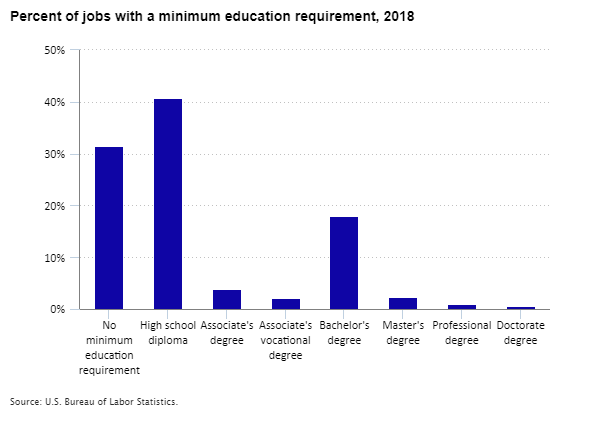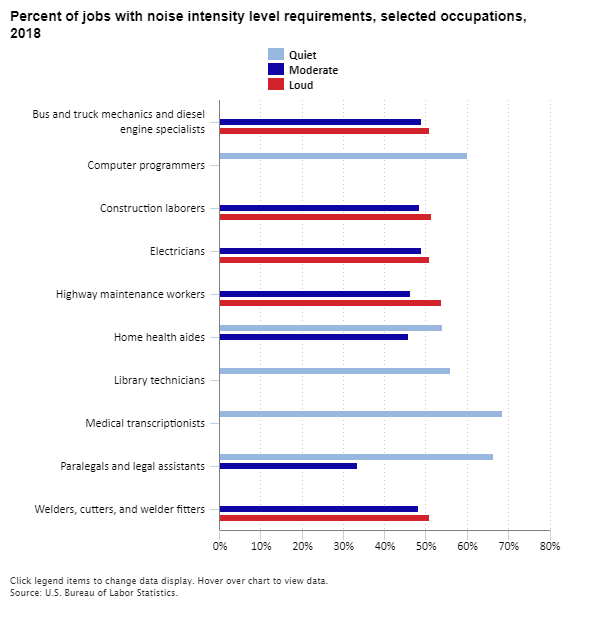You probably know that BLS publishes data and analysis about employment, unemployment, job openings, earnings, productivity, occupational safety and health, and more. But did you know we also publish information about how often workers have to lift objects; the maximum weight they lift or carry; whether they work in extreme heat or cold; and how much training and experience they need for a job? We call these characteristics “occupational requirements.”
What are occupational requirements?
The Occupational Requirements Survey provides information about the requirements of jobs:
- Physical demands of work, such as keyboarding, reaching overhead, lifting or carrying
- Environmental conditions, such as extreme heat, exposure to outdoors, proximity to moving parts
- Education, training, and experience requirements, such as prior work experience, on-the-job training, and license requirements
- Cognitive and mental requirements, such as interaction with other people, independence of work, and the amount of review
How did BLS get into doing this survey?
This survey is one of our newest statistical programs; we first published data on December 1, 2016.
The Social Security Administration asked us to help them obtain accurate and current data to use in their disability programs. They are developing an Occupational Information System, which will use data from the Occupational Requirements Survey. That means the survey is crucial for Social Security to manage their disability programs fairly and efficiently.
How can I use occupational requirements information?
Users of Occupational Requirements Survey data include:
- Researchers exploring occupational change
- Jobseekers and students
- Government agencies evaluating skill gaps
- People with disabilities and their advocates
Let’s discuss a couple of examples to show you what I mean.
Educational requirements
You may want to know the minimum formal education requirements for jobs. The survey has a stat for that! In 2018, a high school diploma was required for jobs covering 40.7 percent of workers, while 17.9 percent had a bachelor’s degree requirement. The chart below shows the percent of jobs by minimum education requirement.

Editor’s note: Data for this chart are available in the table below.
We have more information on education, training, and experience. The 2018 news release showed that on-the-job training was required for about 77 percent of workers, and the average duration was 34 days.
We also have information on preparation time, which includes minimum formal education, training, and work experience a typical worker needs to perform a job. Preparation time between 4 hours and 1 month was required for 31.5 percent of workers.
Environmental Conditions
Is the noise level at your workplace closer to a library (quiet) or a rock concert (very loud)? For some jobseekers, understanding the noise level and other environmental conditions might be extremely important as they evaluate job options. The chart below provides examples of the noise intensity in different occupations.

Editor’s note: Data for this chart are available in the table below.
Examples of work environments with different noise intensity levels include:
- Quiet: private office, a golf course, or art museum
- Moderate: department stores, business office, or fast food restaurant
- Loud: manufacturing plant, atop large earth moving equipment, or jobs next to the highway
- Very loud: rock concert venues, working with jack hammers, or rocket testing areas
How do we collect job requirement data?
To collect job requirement data, our field economists ask business owners, human resource professionals, worker safety officers, and supervisors to collect requirements of work. Field economists do not use paper or online questionnaires to collect these data; instead, they rely on a conversational interviews and descriptive documents, such as task lists, to collect information on occupational requirements.
How are we improving the survey?
Survey scope: Since it began, we have continued to refine the survey to improve its accuracy. In the third year of collection, we redefined the survey scope to focus on critical job functions—that is, the reason the job exists.
Survey content: Beginning with the current sample in collection, we added questions about cognitive and mental requirements. The Social Security Administration asked for this change so we can provide information on the requirements for workers to adapt to changes in the pace of work, solve problems, and interact with others.
Sample: The survey sample is collected over a 5-year period. That will provide the large amount of data necessary to publish information about detailed occupations. We have revised the sampling process to ensure we collect information about less common occupations.
Website: We recently improved the web layout to make it easier for users to find the data they want.
Where is more information?
We have data for occupational groups and occupations through the Occupational Profiles. All data are available through the public data tools. For concepts, methods, and history of the survey see the Handbook of Methods or visit our homepage.
Let us know if you have questions or comments about occupational requirements:
- Phone: (202) 691-6199
Use these gold-standard data to learn more about your job requirements or to find out about new ones. Whatever your occupational requirements question, “We have a stat for that!”
| Education requirement | Percent |
|---|---|
| No minimum education requirement | 31.5% |
| High school diploma | 40.7 |
| Associate’s degree | 3.8 |
| Associate’s vocational degree | 2.1 |
| Bachelor’s degree | 17.9 |
| Master’s degree | 2.3 |
| Professional degree | 0.9 |
| Doctorate degree | 0.5 |
| Occupation | Quiet | Moderate | Loud |
|---|---|---|---|
| Bus and truck mechanics and diesel engine specialists | – | 49.0% | 51.0% |
| Computer programmers | 60.1 | – | – |
| Construction laborers | – | 48.6 | 51.4 |
| Electricians | – | 49.0 | 51.0 |
| Highway maintenance workers | – | 46.2 | 53.8 |
| Home health aides | 54.1 | 45.9 | – |
| Library technicians | 56.0 | – | – |
| Medical transcriptionists | 68.7 | – | – |
| Paralegals and legal assistants | 66.5 | 33.5 | – |
| Welders, cutters, and welder fitters | – | 48.2 | 50.9 |
 United States Department of Labor
United States Department of Labor